Overview
- Brief Narrative
- Political cartoon depicting Soviet Commissar for Foreign Affairs Maksim Litvinov, created by American journalist Albert E. Carter while writing for the Chattanooga Times Free Press in Tennessee, from 1930-1943. He often punctuated his articles with cartoons depicting global news and international leaders. Albert, a college senior, was working as a reporter for the Chattanooga Times when Adolf Hitler was appointed Chancellor of Germany in January 1933. During the mid-1930s, Germany followed a revisionist policy aimed at overcoming the restrictions imposed by the Treaty of Versailles (1919). These policy changes prompted foreign scholars, government officials, and reporters, like Albert, to make their way to Germany to document events. For much of 1934, Albert traveled around Germany by bike while recording his experiences. In 1936, Albert became the Sunday editor and foreign affairs columnist for the paper. Germany, Italy, the Soviet Union, and Japan frequently made international headlines in the second half of the 1930s, and all had leaders represented in Albert’s cartoons. Spurred by a growing interest in South America’s relationship to the US and events in Europe that led up to the war, Albert visited all the nations of South America as a reporter and researcher from 1940 into 1941. Albert returned to the US early in 1941, where he published “The Battle for South America” later that year. In 1943, Albert became a Foreign Service Officer serving in Central and South America for the U.S. State Department. In 1946, Albert married Dorothy Sharp Carter, an American school teacher, in Costa Rica. Dorothy and their four children accompanied Albert while he was posted at embassies throughout his career, including Uruguay, Panama, Paraguay, and Germany.
- Artwork Title
- Litvinoff (sic)
- Date
-
creation:
1930-1943
- Geography
-
creation:
Chattanooga (Tenn.)
- Credit Line
- United States Holocaust Memorial Museum Collection, Gift of Sally Carter
- Signature
- front, beside image, lower left, handwritten, black ink : Al / Carter
- Contributor
-
Artist:
Albert E. Carter
Subject: Albert E. Carter
- Biography
-
Albert Edwin Carter (1909-1992) was born in Big Stone Gap, Virginia, to Reverend Joel Miles (1869-1947) and Mary Melissa Cass (1874-1958) Carter. Joel was born in Tennessee to William (1844-1901) and Mary (1842-1918) Carter and had one brother. Mary Melissa was born in Tennessee to William Marion (1834-1902) and Julia Ann Dorcas Douglass (1836-1879) Cass and had nine siblings and half-siblings. Joel became a Methodist clergyman, following in the footsteps of seven previous generations in his family. Albert had five older siblings: Carroll Douglass (1900-1955), Joseph (1903-?), Clyde Cass (1904-1985), William Eugene (1905-1972), and Mary Juliet (1907-1958). The family moved around southern Virginia for the first decade of Albert’s life. In the 1920s, they settled in Chattanooga, Tennessee. From 1929-1933, Albert attended the University of Chattanooga. By 1930, 20-year-old Albert was working as a cartoonist and reporter for the Chattanooga Times Free Press.
In January 1933, Adolf Hitler was appointed Chancellor of Germany. Anti-Jewish decrees were soon passed that restricted every aspect of Jewish life and altered how many Germans interacted with Jewish community members. During the mid-1930s, Germany followed a revisionist policy aimed at overcoming the restrictions imposed by the Treaty of Versailles (1919). The nation withdrew from the League of Nations, reinstituted the draft, and openly rearmed and remilitarized the Rhineland. These changes prompted many foreign scholars, reporters, government officials, and foreign correspondents, among others, to pay closer attention to Germany. In many cases these individuals, or their representatives, made their way to Germany to document what was happening first hand. In early 1934, Albert was among these individuals that traveled through Germany, in his case, by bike. He documented his experiences throughout the trip. On November 15, 1934, Albert boarded the SS Quistconck on the Italy-controlled island of Susak (now Croatia), and returned to the United States. He arrived on December 12, and then made his way back to Chattanooga. Beginning in 1936, Albert served as the Sunday editor and foreign affairs columnist for the Chattanooga Times. He wrote many articles for the column, and often punctuated the articles with political cartoons. Many of these cartoons depicted national leaders from around the globe, including Germany, Italy, the Soviet Union, and Japan. As part of the revisionist policy approach, Germany provided military assistance to dictator Francisco Franco during the Spanish Civil War (1936-1939), formed a coalition with Benito Mussolini’s Italy, and signed the Anti-Comintern Pact with Japan (1936) and Italy (1937). In September 1939, in accordance with the Molotov-Ribbentrop Pact signed the previous month, Germany invaded western Poland while the Soviet Union annexed eastern Poland, leading Great Britain and France to declare war.
Albert had developed an interest in South America’s relationship to the war in Europe and to the United States. This interest spurred his effort to visit all the nations of South America as a reporter and researcher. This travel was funded by two fellowships from the Julius Rosenwald Fund. Albert likely undertook his travels from 1940 into early 1941. Albert had returned to Tennessee by July 1941, where he compiled his notes and extensive background research into a 300-plus page book titled, The Battle for South America. The book presented a succinct socio-political and economic history of each South American nation. It also examined Germany’s previous relationship with each nation, the economic impact of the German declaration of war, and the overall impact of propaganda, the promise of future economic aid from Germany, and extent of fifth column activity leading up to and during the war. Five months after the book’s publication, Japan’s December 7, 1941, attack on Pearl Harbor in Hawaii, prompted the United States to declare war against Japan and Germany. After several years of intense battles in Northern Africa and throughout the European Theater, Germany surrendered to Allied forces in May 1945. Japan did not surrender in the Pacific Theater until August 1945. During and just after the war, many of the South American nations Albert had studied took in some Jewish refugees, adding to large, existing communities of Western Europeans, many of them German and Italian, on the continent. Following the war, several South American nations, including Bolivia and Argentina, also became safe havens for German war criminals and former Nazis, among them Nikolaus “Klaus” Barbie and Josef Mengele.
In 1943, Albert became a Foreign Service Officer serving in Central and South America for the U.S. State Department. On April 19, 1946, Albert married Dorothy Sharp Carter (1921-2016) in San Jose, Costa Rica. At the time, he was working as a Cultural Attaché for the American Embassy. Dorothy was originally from Chicago, Illinois, but spent much of her childhood in Galveston, Texas. Her parents were Dr. William Barnard and Alice Percy Sharp, and she had one sister, Gloria. Dorothy moved to Oakland, California, to attend college, and received her secondary school teaching credentials from Mills College in 1945. Later that year, Dorothy accepted a position to teach English at the Costa Rican North American Cultural Center in San Jose, where she met Albert. Dorothy and Albert had four children, all of whom were born in different nations between 1947 and 1956. Dorothy and their children accompanied Albert when he was posted at embassies throughout his career, including Uruguay, Panama, Paraguay, and Germany. Between postings, the Carter family would often return to the US. During this time, the Carters lived in Signal Mountain, Tennessee, Galveston, Texas, and Washington, D.C. After Albert’s retirement from the State Department in 1969, he and Dorothy moved to Austin, Texas. During this period, Dorothy authored several children’s books. Following Albert’s death, Dorothy moved to Herndon, Virginia, to live with their youngest child.
Physical Details
- Language
- English
- Classification
-
Art
- Category
-
Caricatures and cartoons
- Object Type
-
Cartoons (lcsh)
- Genre/Form
- Cartoons (Commentary)
- Physical Description
- Black-and-white political cartoon, hand drawn in black ink on heavyweight, tan paper, depicting a portrait of Maksim Litvinov (Maxim Litvinoff) from the chest up. He is centered on the page in left profile, and is depicted wearing a heavily shaded, white fedora-style hat with a narrow black band. There is a small section of thin, black hair just visible behind his left ear. He has short, thick eyebrows just visible above small, half-lidded eyes behind the round lenses of wire rimmed glasses. His nose is short, but large and prominent, the bulbous tip protruding beyond his lips, which are pulled back in a slight smile. His mouth is partially open and a few small, upper teeth are visible between full lips. A small, rounded chin extends just beneath his mouth with a large, fleshy double chin beneath it. He wears a white shirt with a high stand collar, which obscures his neck. The points of the collar are folded down slightly at the front, so the narrow, black tie is still visible around the collar. He wears a light-colored jacket with notched lapels, a pocket square in his breast pocket, and three buttons at the cuff. He holds a rolled piece of paper, perhaps a newspaper or documents, in his left hand, which rests against his chest. Hooked over his wrist is handle of an umbrella or cane, and his arm angles down and away slightly, as though his elbow is bent. He is highlighted by cross-hatched patches to either side of his face, and along his shoulders. The artist’s signature is visible just below and to the left of his hand. A line of script identifying the man is penciled above him. The edges of the paper are slightly irregular and there are pinholes in the upper corners. The paper is discolored throughout, especially at the bottom.
- Dimensions
- overall: Height: 11.750 inches (29.845 cm) | Width: 9.125 inches (23.178 cm)
- Materials
- overall : paper, ink, pencil
- Inscription
- front, above image, center, handwritten, pencil : Litvinoff (sic)
Rights & Restrictions
- Conditions on Access
- No restrictions on access
- Conditions on Use
- No restrictions on use
Keywords & Subjects
Administrative Notes
- Legal Status
- Permanent Collection
- Provenance
- The political cartoon was donated to the United States Holocaust Memorial Museum in 2018 by Sally Carter, the daughter of Albert E. Carter.
- Record last modified:
- 2024-03-04 09:02:27
- This page:
- https://collections.ushmm.org/search/catalog/irn621679
Download & Licensing
In-Person Research
- By Appointment
- Request 21 Days in Advance of Visit
- Plan a Research Visit
- Request to See This Object
Contact Us
Also in Albert E. Carter collection
The collection consists of political cartoons, a book, and newspaper articles relating to the experiences of Albert E. Carter as a journalist in the United States, Germany, and South America before and during World War II.
Date: approximately 1930-1943
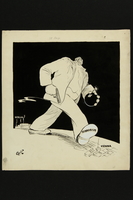
Political cartoon depicting terrorism in Europe created by an American journalist
Object
Political cartoon depicting European terrorism as a giant, created by American journalist Albert E. Carter while writing for the Chattanooga Times Free Press in Tennessee, from 1930-1943. He often punctuated his articles with cartoons depicting global news and international leaders. Albert, a college senior, was working as a reporter for the Chattanooga Times when Adolf Hitler was appointed Chancellor of Germany in January 1933. During the mid-1930s, Germany followed a revisionist policy aimed at overcoming the restrictions imposed by the Treaty of Versailles (1919). These policy changes prompted foreign scholars, government officials, and reporters, like Albert, to make their way to Germany to document events. For much of 1934, Albert traveled around Germany by bike while recording his experiences. In 1936, Albert became the Sunday editor and foreign affairs columnist for the paper. Germany, Italy, the Soviet Union, and Japan frequently made international headlines in the second half of the 1930s, and all had leaders represented in Albert’s cartoons. Spurred by a growing interest in South America’s relationship to the US and events in Europe that led up to the war, Albert visited all the nations of South America as a reporter and researcher from 1940 into 1941. Albert returned to the US early in 1941, where he published “The Battle for South America” later that year. In 1943, Albert became a Foreign Service Officer serving in Central and South America for the U.S. State Department. In 1946, Albert married Dorothy Sharp Carter, an American school teacher, in Costa Rica. Dorothy and their four children accompanied Albert while he was posted at embassies throughout his career, including Uruguay, Panama, Paraguay, and Germany.
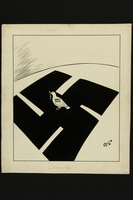
Political cartoon depicting world peace perched on a swastika created by an American journalist
Object
Political cartoon depicting world peace as a dove perched on a swastika, created by American journalist Albert E. Carter while writing for the Chattanooga Times Free Press in Tennessee, from 1930-1943. He often punctuated his articles with cartoons depicting global news and international leaders. Albert, a college senior, was working as a reporter for the Chattanooga Times when Adolf Hitler was appointed Chancellor of Germany in January 1933. During the mid-1930s, Germany followed a revisionist policy aimed at overcoming the restrictions imposed by the Treaty of Versailles (1919). These policy changes prompted foreign scholars, government officials, and reporters, like Albert, to make their way to Germany to document events. For much of 1934, Albert traveled around Germany by bike while recording his experiences. In 1936, Albert became the Sunday editor and foreign affairs columnist for the paper. Germany, Italy, the Soviet Union, and Japan frequently made international headlines in the second half of the 1930s, and all had leaders represented in Albert’s cartoons. Spurred by a growing interest in South America’s relationship to the US and events in Europe that led up to the war, Albert visited all the nations of South America as a reporter and researcher from 1940 into 1941. Albert returned to the US early in 1941, where he published “The Battle for South America” later that year. In 1943, Albert became a Foreign Service Officer serving in Central and South America for the U.S. State Department. In 1946, Albert married Dorothy Sharp Carter, an American school teacher, in Costa Rica. Dorothy and their four children accompanied Albert while he was posted at embassies throughout his career, including Uruguay, Panama, Paraguay, and Germany.
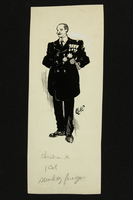
Political cartoon depicting King Christian X of Denmark created by an American journalist
Object
Political cartoon depicting King Christian X of Denmark, created by American journalist Albert E. Carter while he was the Sunday editor and foreign affairs columnist for the Chattanooga Times Free Press in Tennessee, from 1936-1943. He often punctuated his articles with cartoons depicting global news and international leaders. Albert, a college senior, was working as a reporter for the Chattanooga Times when Adolf Hitler was appointed Chancellor of Germany in January 1933. During the mid-1930s, Germany followed a revisionist policy aimed at overcoming the restrictions imposed by the Treaty of Versailles (1919). These policy changes prompted foreign scholars, government officials, and reporters, like Albert, to make their way to Germany to document events. For much of 1934, Albert traveled around Germany by bike while recording his experiences. In 1936, Albert became the Sunday editor and foreign affairs columnist for the paper. Germany, Italy, the Soviet Union, and Japan frequently made international headlines in the second half of the 1930s, and all had leaders represented in Albert’s cartoons. Spurred by a growing interest in South America’s relationship to the US and events in Europe that led up to the war, Albert visited all the nations of South America as a reporter and researcher from 1940 into 1941. Albert returned to the US early in 1941, where he published “The Battle for South America” later that year. In 1943, Albert became a Foreign Service Officer serving in Central and South America for the U.S. State Department. In 1946, Albert married Dorothy Sharp Carter, an American school teacher, in Costa Rica. Dorothy and their four children accompanied Albert while he was posted at embassies throughout his career, including Uruguay, Panama, Paraguay, and Germany.
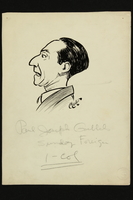
Political cartoon depicting Joseph Goebbels created by an American journalist
Object
Political cartoon depicting German Minister of Public Enlightenment and Propaganda Joseph Goebbels, created by American journalist Albert E. Carter while he was the Sunday editor and foreign affairs columnist for the Chattanooga Times Free Press in Tennessee, from 1936-1943. He often punctuated his articles with cartoons depicting global news and international leaders. Albert, a college senior, was working as a reporter for the Chattanooga Times when Adolf Hitler was appointed Chancellor of Germany in January 1933. During the mid-1930s, Germany followed a revisionist policy aimed at overcoming the restrictions imposed by the Treaty of Versailles (1919). These policy changes prompted foreign scholars, government officials, and reporters, like Albert, to make their way to Germany to document events. For much of 1934, Albert traveled around Germany by bike while recording his experiences. In 1936, Albert became the Sunday editor and foreign affairs columnist for the paper. Germany, Italy, the Soviet Union, and Japan frequently made international headlines in the second half of the 1930s, and all had leaders represented in Albert’s cartoons. Spurred by a growing interest in South America’s relationship to the US and events in Europe that led up to the war, Albert visited all the nations of South America as a reporter and researcher from 1940 into 1941. Albert returned to the US early in 1941, where he published “The Battle for South America” later that year. In 1943, Albert became a Foreign Service Officer serving in Central and South America for the U.S. State Department. In 1946, Albert married Dorothy Sharp Carter, an American school teacher, in Costa Rica. Dorothy and their four children accompanied Albert while he was posted at embassies throughout his career, including Uruguay, Panama, Paraguay, and Germany.
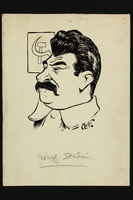
Political cartoon depicting Joseph Stalin created by an American journalist
Object
Political cartoon depicting Soviet General Secretary Joseph Stalin, created by American journalist Albert E. Carter while writing for the Chattanooga Times Free Press in Tennessee, from 1930–1943. He often punctuated his articles with cartoons depicting global news and international leaders. Albert, a college senior, was working as a reporter for the Chattanooga Times when Adolf Hitler was appointed Chancellor of Germany in January 1933. During the mid-1930s, Germany followed a revisionist policy aimed at overcoming the restrictions imposed by the Treaty of Versailles (1919). These policy changes prompted foreign scholars, government officials, and reporters, like Albert, to make their way to Germany to document events. For much of 1934, Albert traveled around Germany by bike while recording his experiences. In 1936, Albert became the Sunday editor and foreign affairs columnist for the paper. Germany, Italy, the Soviet Union, and Japan frequently made international headlines in the second half of the 1930s, and all had leaders represented in Albert’s cartoons. Spurred by a growing interest in South America’s relationship to the US and events in Europe that led up to the war, Albert visited all the nations of South America as a reporter and researcher from 1940 into 1941. Albert returned to the US early in 1941, where he published “The Battle for South America” later that year. In 1943, Albert became a Foreign Service Officer serving in Central and South America for the U.S. State Department. In 1946, Albert married Dorothy Sharp Carter, an American school teacher, in Costa Rica. Dorothy and their four children accompanied Albert while he was posted at embassies throughout his career, including Uruguay, Panama, Paraguay, and Germany.
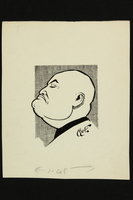
Political cartoon depicting Benito Mussolini created by an American journalist
Object
Political cartoon depicting Italian Prime Minister Benito Mussolini, created by American journalist Albert E. Carter while writing for the Chattanooga Times Free Press in Tennessee, from 1930-1943. He often punctuated his articles with cartoons depicting global news and international leaders. Albert, a college senior, was working as a reporter for the Chattanooga Times when Adolf Hitler was appointed Chancellor of Germany in January 1933. During the mid-1930s, Germany followed a revisionist policy aimed at overcoming the restrictions imposed by the Treaty of Versailles (1919). These policy changes prompted foreign scholars, government officials, and reporters, like Albert, to make their way to Germany to document events. For much of 1934, Albert traveled around Germany by bike while recording his experiences. In 1936, Albert became the Sunday editor and foreign affairs columnist for the paper. Germany, Italy, the Soviet Union, and Japan frequently made international headlines in the second half of the 1930s, and all had leaders represented in Albert’s cartoons. Spurred by a growing interest in South America’s relationship to the US and events in Europe that led up to the war, Albert visited all the nations of South America as a reporter and researcher from 1940 into 1941. Albert returned to the US early in 1941, where he published “The Battle for South America” later that year. In 1943, Albert became a Foreign Service Officer serving in Central and South America for the U.S. State Department. In 1946, Albert married Dorothy Sharp Carter, an American school teacher, in Costa Rica. Dorothy and their four children accompanied Albert while he was posted at embassies throughout his career, including Uruguay, Panama, Paraguay, and Germany.
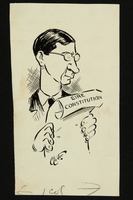
Political cartoon depicting Éamon de Valera holding the Éire Constitution created by an American journalist
Object
Political cartoon depicting Prime Minister of Ireland Éamon de Valera, created by American journalist Albert E. Carter while he was the Sunday editor and foreign affairs columnist for the Chattanooga Times Free Press in Tennessee, from 1936-1943. He often punctuated his articles with cartoons depicting global news and international leaders. Albert, a college senior, was working as a reporter for the Chattanooga Times when Adolf Hitler was appointed Chancellor of Germany in January 1933. During the mid-1930s, Germany followed a revisionist policy aimed at overcoming the restrictions imposed by the Treaty of Versailles (1919). These policy changes prompted foreign scholars, government officials, and reporters, like Albert, to make their way to Germany to document events. For much of 1934, Albert traveled around Germany by bike while recording his experiences. In 1936, Albert became the Sunday editor and foreign affairs columnist for the paper. Germany, Italy, the Soviet Union, and Japan frequently made international headlines in the second half of the 1930s, and all had leaders represented in Albert’s cartoons. Spurred by a growing interest in South America’s relationship to the US and events in Europe that led up to the war, Albert visited all the nations of South America as a reporter and researcher from 1940 into 1941. Albert returned to the US early in 1941, where he published “The Battle for South America” later that year. In 1943, Albert became a Foreign Service Officer serving in Central and South America for the U.S. State Department. In 1946, Albert married Dorothy Sharp Carter, an American school teacher, in Costa Rica. Dorothy and their four children accompanied Albert while he was posted at embassies throughout his career, including Uruguay, Panama, Paraguay, and Germany.
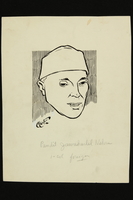
Political cartoon depicting Jawaharlal Nehru created by an American journalist
Object
Political cartoon depicting Indian politician and supporter of independence Jawaharlal Nehru, created by American journalist Albert E. Carter while he was the Sunday editor and foreign affairs columnist for the Chattanooga Times Free Press in Tennessee, from 1936-1943. He often punctuated his articles with cartoons depicting global news and international leaders. Albert, a college senior, was working as a reporter for the Chattanooga Times when Adolf Hitler was appointed Chancellor of Germany in January 1933. During the mid-1930s, Germany followed a revisionist policy aimed at overcoming the restrictions imposed by the Treaty of Versailles (1919). These policy changes prompted foreign scholars, government officials, and reporters, like Albert, to make their way to Germany to document events. For much of 1934, Albert traveled around Germany by bike while recording his experiences. In 1936, Albert became the Sunday editor and foreign affairs columnist for the paper. Germany, Italy, the Soviet Union, and Japan frequently made international headlines in the second half of the 1930s, and all had leaders represented in Albert’s cartoons. Spurred by a growing interest in South America’s relationship to the US and events in Europe that led up to the war, Albert visited all the nations of South America as a reporter and researcher from 1940 into 1941. Albert returned to the US early in 1941, where he published “The Battle for South America” later that year. In 1943, Albert became a Foreign Service Officer serving in Central and South America for the U.S. State Department. In 1946, Albert married Dorothy Sharp Carter, an American school teacher, in Costa Rica. Dorothy and their four children accompanied Albert while he was posted at embassies throughout his career, including Uruguay, Panama, Paraguay, and Germany.
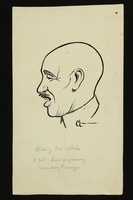
Political cartoon depicting Chiang Kai-shek created by an American journalist
Object
Political cartoon depicting Chinese Chairman of the Military Affairs Commission Chiang Kai-shek, created by American journalist Albert E. Carter while he was the Sunday editor and foreign affairs columnist for the Chattanooga Times Free Press in Tennessee, from 1936-1943. He often punctuated his articles with cartoons depicting global news and international leaders. Albert, a college senior, was working as a reporter for the Chattanooga Times when Adolf Hitler was appointed Chancellor of Germany in January 1933. During the mid-1930s, Germany followed a revisionist policy aimed at overcoming the restrictions imposed by the Treaty of Versailles (1919). These policy changes prompted foreign scholars, government officials, and reporters, like Albert, to make their way to Germany to document events. For much of 1934, Albert traveled around Germany by bike while recording his experiences. In 1936, Albert became the Sunday editor and foreign affairs columnist for the paper. Germany, Italy, the Soviet Union, and Japan frequently made international headlines in the second half of the 1930s, and all had leaders represented in Albert’s cartoons. Spurred by a growing interest in South America’s relationship to the US and events in Europe that led up to the war, Albert visited all the nations of South America as a reporter and researcher from 1940 into 1941. Albert returned to the US early in 1941, where he published “The Battle for South America” later that year. In 1943, Albert became a Foreign Service Officer serving in Central and South America for the U.S. State Department. In 1946, Albert married Dorothy Sharp Carter, an American school teacher, in Costa Rica. Dorothy and their four children accompanied Albert while he was posted at embassies throughout his career, including Uruguay, Panama, Paraguay, and Germany.
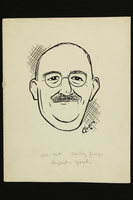
Political cartoon depicting Agustín Justo created by an American journalist
Object
Political cartoon depicting Argentinian President Agustín Justo (1932-1938), created by American journalist Albert E. Carter while he was the Sunday editor and foreign affairs columnist for the Chattanooga Times Free Press in Tennessee, from 1936-1943. He often punctuated his articles with cartoons depicting global news and international leaders. Albert, a college senior, was working as a reporter for the Chattanooga Times when Adolf Hitler was appointed Chancellor of Germany in January 1933. During the mid-1930s, Germany followed a revisionist policy aimed at overcoming the restrictions imposed by the Treaty of Versailles (1919). These policy changes prompted foreign scholars, government officials, and reporters, like Albert, to make their way to Germany to document events. For much of 1934, Albert traveled around Germany by bike while recording his experiences. In 1936, Albert became the Sunday editor and foreign affairs columnist for the paper. Germany, Italy, the Soviet Union, and Japan frequently made international headlines in the second half of the 1930s, and all had leaders represented in Albert’s cartoons. Spurred by a growing interest in South America’s relationship to the US and events in Europe that led up to the war, Albert visited all the nations of South America as a reporter and researcher from 1940 into 1941. Albert returned to the US early in 1941, where he published “The Battle for South America” later that year. In 1943, Albert became a Foreign Service Officer serving in Central and South America for the U.S. State Department. In 1946, Albert married Dorothy Sharp Carter, an American school teacher, in Costa Rica. Dorothy and their four children accompanied Albert while he was posted at embassies throughout his career, including Uruguay, Panama, Paraguay, and Germany.
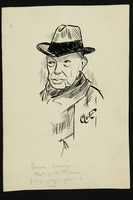
Political cartoon depicting Prince Saionji Kinmochi created by an American journalist
Object
Political cartoon depicting former Japanese Prime Minister and the nation’s last elder statesman, Prince Saionji Kinmochi, created by American journalist Albert E. Carter while he was the Sunday editor and foreign affairs columnist for the Chattanooga Times Free Press in Tennessee, from 1936-1943. He often punctuated his articles with cartoons depicting global news and international leaders. Albert, a college senior, was working as a reporter for the Chattanooga Times when Adolf Hitler was appointed Chancellor of Germany in January 1933. During the mid-1930s, Germany followed a revisionist policy aimed at overcoming the restrictions imposed by the Treaty of Versailles (1919). These policy changes prompted foreign scholars, government officials, and reporters, like Albert, to make their way to Germany to document events. For much of 1934, Albert traveled around Germany by bike while recording his experiences. In 1936, Albert became the Sunday editor and foreign affairs columnist for the paper. Germany, Italy, the Soviet Union, and Japan frequently made international headlines in the second half of the 1930s, and all had leaders represented in Albert’s cartoons. Spurred by a growing interest in South America’s relationship to the US and events in Europe that led up to the war, Albert visited all the nations of South America as a reporter and researcher from 1940 into 1941. Albert returned to the US early in 1941, where he published “The Battle for South America” later that year. In 1943, Albert became a Foreign Service Officer serving in Central and South America for the U.S. State Department. In 1946, Albert married Dorothy Sharp Carter, an American school teacher, in Costa Rica. Dorothy and their four children accompanied Albert while he was posted at embassies throughout his career, including Uruguay, Panama, Paraguay, and Germany.
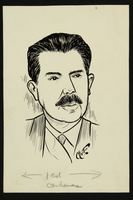
Political cartoon depicting Lázaro Cárdenas created by an American journalist
Object
Political cartoon depicting Mexican President Lázaro Cárdenas, created by American journalist Albert E. Carter while writing for the Chattanooga Times Free Press in Tennessee, from 1930-1943. He often punctuated his articles with cartoons depicting global news and international leaders. Albert, a college senior, was working as a reporter for the Chattanooga Times when Adolf Hitler was appointed Chancellor of Germany in January 1933. During the mid-1930s, Germany followed a revisionist policy aimed at overcoming the restrictions imposed by the Treaty of Versailles (1919). These policy changes prompted foreign scholars, government officials, and reporters, like Albert, to make their way to Germany to document events. For much of 1934, Albert traveled around Germany by bike while recording his experiences. In 1936, Albert became the Sunday editor and foreign affairs columnist for the paper. Germany, Italy, the Soviet Union, and Japan frequently made international headlines in the second half of the 1930s, and all had leaders represented in Albert’s cartoons. Spurred by a growing interest in South America’s relationship to the US and events in Europe that led up to the war, Albert visited all the nations of South America as a reporter and researcher from 1940 into 1941. Albert returned to the US early in 1941, where he published “The Battle for South America” later that year. In 1943, Albert became a Foreign Service Officer serving in Central and South America for the U.S. State Department. In 1946, Albert married Dorothy Sharp Carter, an American school teacher, in Costa Rica. Dorothy and their four children accompanied Albert while he was posted at embassies throughout his career, including Uruguay, Panama, Paraguay, and Germany.
Albert Carter papers
Document
Collection of newspapers articles written and created by American journalist Albert E. Carter, who created political cartoons and wrote for the Chattanooga Times in Tennessee from circa 1930-1940. In 1934, Carter traveled to Europe for many months and detailed his experiences bicycling and traveling through Nazi Germany.



